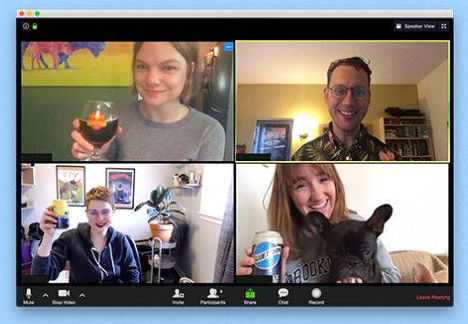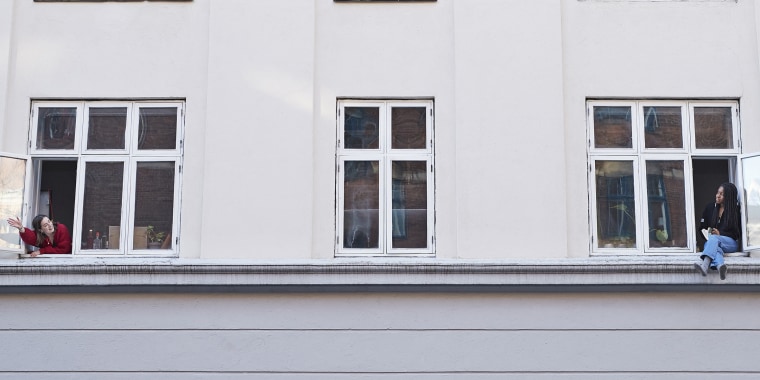With restaurants and other nonessential businesses reopening across the country, many Americans have taken this as a sign it’s safe to return to behavior from before the coronavirus lockdown.
The truth is, though, whether you can socialize freely depends largely on where you live, Dr. Sten Vermund, dean of Yale’s School of Public Health in New Haven, Connecticut, told TODAY.
For example, in towns where the case count is zero, it may be safe “to go back to life normally,” he said. For areas with relatively low circulation of the virus, he added, the question for public health professionals becomes: What’s the probability that social interaction will “rekindle the forest fire” of widespread transmission?
Regardless of the state you live in, knowing the case counts and local guidance for your area is paramount. Vermund recommended websites like COVIDcommitment.org and HowWeFeel.org.
This data should inform how you decide to socialize, if at all, as nothing right now is “100% risk-free,” Robert Bednarczyk, PhD, professor at Rollins School of Public Health at Emory University in Atlanta, Georgia, told TODAY.
Here’s more specific guidance to determine if it’s safe to see friends and family now and in the future.
Is it safe to see friends right now?
Again, the answer depends largely on where you live. If that’s an area that still has stay-at-home orders in place, like New York City or Los Angeles, then you should stick to socializing just with people in your household, Hilary Godwin, PhD, dean of University of Washington’s School of Public Health in Seattle, told TODAY.
If you live in an area with loosened restrictions and decreasing case counts, then you may consider socializing in small groups while taking precautions — primarily prioritizing outdoor settings and maintaining a distance of 6 feet. If that distance isn’t possible, then consider wearing a face covering or ditching the activity altogether. And of course, clean your hands regularly throughout your interactions.
Right now, most if not all states have banned mass gatherings, like you’d see at a bar or concert. So continue to avoid these settings, even outdoors, and don’t have large groups at your home.
For interactions less packed than parties but aren’t outdoors with 6 feet, Bednarczyk explained that there’s “spectrum” of safety. “It’s not necessarily a good-versus-bad type of situation … Having one person over to your house is at a lower end of the spectrum.”
Godwin also stressed that the physical distance aspect is the most important part of reducing risk.
“The most frequent way (COVID-19) seems to be spreading is people in close proximity to each other indoors for extended periods of time,” she explained. “The perfect way to reintroduce getting together socially with friends would be sitting out on your front porch on chairs that are 6 feet apart … hanging out with good separation outside where there’s air circulating.”
How can we socialize safely in the coming weeks to months?
Following guidance from local health departments is the best way to gauge what’s safe, Vermund said, adding that until there are explicit changes, take as many precautions as possible.
In the absence of specific rules, Godwin advised expanding social interactions slowly so authorities can determine whether they’re impacting the spread of the coronavirus in the community. It’s not “a light switch” where groups gathering will suddenly be safe, she said.
Before meeting up with friends, look for signs that your community can handle the risk, Godwin continued. For example, if you live in an area with sparse testing or frequent news coverage of an overwhelmed health care system, these are signs it’s not a good time to expand your circle.
If you choose to socialize with people outside your household, she recommended picking “COVID buddies” — people who only interact with each other and have similar risks related to the coronavirus and behavioral patterns. You also want people with similar “philosophies on precautions,” she said. This way, if one person takes risks, there’s no unnecessary exposure for others because the rest of the group behaves the same way.
But again, keep an eye on your local health department’s website. It can take weeks for the effects of reopening to materialize, and it’s possible that restrictions will tighten again, Vermund said.
What will the rest of the year look like for social interactions?
It’s too soon to say whether you can attend that postponed graduation party. Transmission rates could drop during the summer, but they also could increase again in the fall and winter.
“What we’re all hoping for is in the next month or two, most regions will start shifting into this limited social interaction phase,” Godwin said. “While we’re in that phase, we’ll check to make sure the number of cases don’t get out of control, and then we’ll start allowing slightly larger gatherings.”
In the mean time, pay attention to state and local guidance, and follow the big four, as Vermund called them:
- Physical distance of 6 feet
- Face coverings
- Hand hygiene
- Opting for the outdoors
What if you’re high risk for the coronavirus?
For demographics who could become severely ill from COVID-19, like people over 65 or with underlying conditions, the inevitable risks of social interaction are greater. These groups “need to avoid getting infected at all costs,” Vermund said.
So, be “aggressive” about precautions, he added. Tell people around you to wear masks and maintain 6 feet of distance. In addition, Godwin encouraged these individuals to self-isolate ideally until there are no cases of the coronavirus in their area.
When in doubt, trust recommendations put out by state and local authorities and the Centers for Disease Control and Prevention.
“I’ve been an infectious epidemiologist for 40 years, but I’m not second-guessing what my governor is telling me,” Vermund said.



